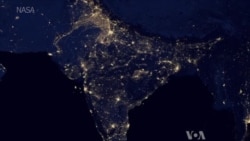BOULDER, COLORADO —
Stargazing is a vastly different experience today then it was a century ago. Fabio Mezzalira, director of the observatory at the University of Colorado at Boulder, blames the artificial lights that turn our cities as bright as day.
“People at one time, knew, by default, the sky," he said. "They understood the sky. They saw it every night, simply because there was no light pollution to be worried about.”
Light pollution is now commonplace. The glow of the world's urban areas is even visible from space, in images from NASA's orbiting cameras.
An impact on health
All that light can affect people's health by disrupting the body's natural sleep cycle, says journalist Paul Bogard.
“All life evolved in bright days and dark nights," he observed. "Life needs darkness to be truly healthy. We’re using way too much light."
In his book, The End of Night, Searching for Natural Darkness in an Age of Artificial Light, Bogard estimates people today are missing up to 99 percent of the stars they should be seeing.
"You can go to a large city or to an American neighborhood that’s lit up, and you can see the brightest stars, but we quickly lose sight of all the stars that are dimmer than the brightest," he said. "And that’s the real loss."
Boulder, Colorado, has less light pollution than most cities. That’s because the city passed a light pollution ordinance a decade ago. Among its requirements are that streetlights point down, focusing their light on the sidewalk, rather than shining up into the sky, where the light is wasted.
Nancy Clanton, a Boulder lighting engineer, and a leader of the International Dark Sky Association explained, "The ordinance was basically saying, let’s start with no uplight, so it says, use what we call full cut-off lights, which are fully shielded."
Boulder also has some residential areas with no streetlights at all.
A sky 'gray with stars'
Seeing a sky dense with stars leaves an indelible mark.
On his website, dakotalapse.com, photographer Randy Halverson writes that the landscape of South Dakota, where he grew up, is beautiful, but "doesn’t compare to what the sky can do, especially at night," and he proves it with time-lapse video of the heavens
University of Colorado observatory director Fabio Mezzalira recalled a memorable star gazing experience.
"The first time I really realized more the universe around me was when I was about 11 years old, and I was laying on a beach and there was no light pollution," he said. "Zero. You could see the Milky Way, and the sky was gray with stars."
The International Dark Sky Association offers model lighting plans on its website for communities that want to limit light pollution and keep the stars in view.
“People at one time, knew, by default, the sky," he said. "They understood the sky. They saw it every night, simply because there was no light pollution to be worried about.”
Light pollution is now commonplace. The glow of the world's urban areas is even visible from space, in images from NASA's orbiting cameras.
An impact on health
All that light can affect people's health by disrupting the body's natural sleep cycle, says journalist Paul Bogard.
“All life evolved in bright days and dark nights," he observed. "Life needs darkness to be truly healthy. We’re using way too much light."
In his book, The End of Night, Searching for Natural Darkness in an Age of Artificial Light, Bogard estimates people today are missing up to 99 percent of the stars they should be seeing.
"You can go to a large city or to an American neighborhood that’s lit up, and you can see the brightest stars, but we quickly lose sight of all the stars that are dimmer than the brightest," he said. "And that’s the real loss."
Boulder, Colorado, has less light pollution than most cities. That’s because the city passed a light pollution ordinance a decade ago. Among its requirements are that streetlights point down, focusing their light on the sidewalk, rather than shining up into the sky, where the light is wasted.
Nancy Clanton, a Boulder lighting engineer, and a leader of the International Dark Sky Association explained, "The ordinance was basically saying, let’s start with no uplight, so it says, use what we call full cut-off lights, which are fully shielded."
Horizons from Randy Halverson on Vimeo.
Boulder also has some residential areas with no streetlights at all.
A sky 'gray with stars'
Seeing a sky dense with stars leaves an indelible mark.
On his website, dakotalapse.com, photographer Randy Halverson writes that the landscape of South Dakota, where he grew up, is beautiful, but "doesn’t compare to what the sky can do, especially at night," and he proves it with time-lapse video of the heavens
University of Colorado observatory director Fabio Mezzalira recalled a memorable star gazing experience.
"The first time I really realized more the universe around me was when I was about 11 years old, and I was laying on a beach and there was no light pollution," he said. "Zero. You could see the Milky Way, and the sky was gray with stars."
The International Dark Sky Association offers model lighting plans on its website for communities that want to limit light pollution and keep the stars in view.






